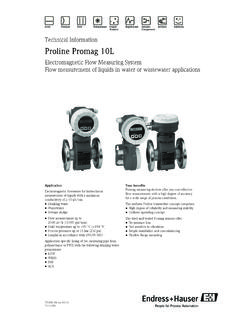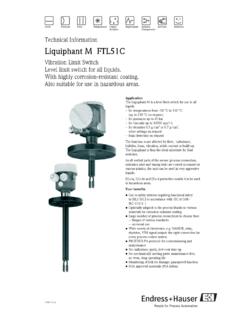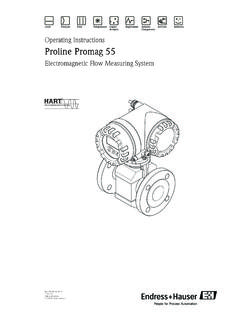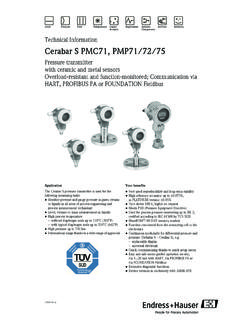Transcription of silometer FMC 420 Level measurement - shin …
1 SilometerFMC 420 Level measurementOperating InstructionsSEAFINUMLDSORECMER420 ESTSE+RH130 V20 mA121110987BA 179F/00/ (a)017326-1000 Hauser+EndressThe Power of Know HowShort VRi>5k + 1. Basic settings0Va)b)0%2. Calibration with anemptyvessel10 V100 %display fallsdisplay risesdisplayrises3. Calibration with afullvesselShort InstructionsSilometer FMC 420 Table of Contents1 Notes on Special notes on General notes on safety52 The Measuring Function63 Mounting74 Electrical Connection85 Preparing for Calibration with an empty vessel (0%) Calibration with a full vessel136 Technical Data147 Supplementary documentation158 Replacing an instrument15 silometer FMC 420 Table of Contents1 Notes on Special notes on safetyApproved usageThe silometer FMC 420 is designed for continuous Level measurement in liquids andis to be installed in non-explosion hazardous Technical Data for limit ,commissioning,operationThe device has been designed to operate safely in accordance with current technical,safety and EU standards.
2 If installed incorrectly or used for applications for which it isnot intended, however, it is possible that application-related dangers may arise, overflow or explosion in an ignition-hazardous this reason, the instrument must be installed, connected, operated andmaintained by personnel that are authorised by the user of the facility and who aresuitably qualified. The manual must have been read and understood, and theinstructions followed. Modifications and repairs to the device are permissible onlywhen they are expressly approved in the Notes on SafetySilometer FMC 4204 Endress+ General notes on safetyIn order to highlight safety-relevant or alternative operating procedures in the manual,the following conventions have been used, each indicated by a corresponding icon inthe conventionsNote!A note highlights actions or procedures which, if not performed correctly,may indirectly affect operation or may lead to an instrument response which is not !
3 Caution highlights actions or procedures which, if not performed correctly,may lead to personal injury or incorrect function of the !A warning highlights actions or procedures which, if not performed correctly,will lead to personal injury, a safety hazard or destruction of the voltageA terminal to which or from which a direct current or voltage may be applied or symbolsAlternating voltageA terminal to which or from which an alternating (sine-wave) current or voltagemay be applied or terminal (functioning ground terminal)A grounded terminal, which as far as the operator is concerned,is already grounded by means of an earth grounding groundingA terminal which must be connected to earth ground prior to making any other connectionto the connectionA connection must be made to the plant grounding system which may be of equipotential line or neutral star according to national or company !
4 Caution!Warning! silometer FMC 4201 Notes on SafetyEndress+Hauser52 ApplicationThe silometer FMC 420 is used for continuous Level measurement in liquid complete programme of capacitance and hydrostatic probes (pressure sensors)enables measurement to be carried out: in aggressive media at high pressures and in vacuum at high and low temperatures in high and low viscous liquids in media tending to form The Measuring SystemComponents of the measuring system: Transmitter: silometer FMC 420 Sensor: capacitive probe with electronic insert (transmitter) EC 11 Z or EC 72 Zor hydrostatic probe (pressure sensor) Deltapilot S with transmitterFEB 11 or FEB 11 FunctionThe silometer FMC 420 supplies the sensor with its integrated transmitter with directcurrent and receives from it a Level -proportional signal of approx. standardised signals V and mA (or mA) are available at theSilometer output for remote display of the green LED indicates stand-by.
5 0 VSilometerFMC 420 Levelorcapacitive probewith EC 11 Z or EC 72 ZBA179Y01hydrostatic probeDeltapilot S with FEB 11 or FEB 11 PFig. 1 The measurement system Level -proportionalanalogue output signalfor current and voltage2 ApplicationSilometer FMC 4206 Endress+Hauser3 MountingSilometer FMC 420 Compare the product designation on the nameplate of your instrument with that ofthe product structure (see below) to ensure that the correct instrument is beingmounted. Install the silometer in a control cabinet or in a protective housing (accessory). Observe the permissible ambient temperature (see technical data) and the minimumdistance between instruments (Fig. 2)ProbesNote the mounting recommendations in the Technical Information brochures for 25 mm1117537,52 DINtop-hat railremovableterminal blockfor mainsconnectionmounthereBA179Y02pull out eyeforunlockingsnap inhereremovable terminal blockfor signal cablesFig.
6 2left:Dimensions in mmof the Silometerin Minipac versionHousing width: 50 mm Mounting on a DIN top-hat rail35 x or 35 x 15 Observe minimum interval tothe next row of instrumentsabove and : silometer FMC 420 Mounting, removal100 mm = inFMC 420 SilometerCertificates, ApprovalsR Standard (not certified)CCSA versionVersion0 Minipac housing, 50 mm, with terminal strip9 OtherPower SupplyJAC 240 V, 50/60 HzAAC V, 50/60 HzFAC 115 V, 50/60 HzBAC 110 V, 50/60 HzD AC 24 V, 50/60 HzYOtherAnalogue Outputs10 mA, V9 OtherFMC 420 -Product designationProduct structureSilometer FMC 4203 MountingEndress+Hauser74 Electrical ConnectionThe silometer may only be connected by trained the probe withthe electronic insertUse screened three-core cable, cable resistance max. 25 .Note!For general installation instructions with strong interference sources,see Technical Information TI 241F/00 grounding the cable screening at both ends is not possible then ground thescreening preferably at the probe housing (vessel potential).
7 After connecting, screw down the cover of the probe securely and seal the cableentry the signaloutputsYou may connect as many peripheral instruments as required to the V voltageoutput, such as voltmeters, plotters, limit signal switches, etc. in parallel provided thetotal load resistance is larger than 5 k .The voltage output is resistant to may connect as many peripheral instruments as required in series to mA or mA current output, such as ammeters, plotters, controllers, the total load resistance is smaller than 500 .Note!The current and voltage outputs are galvanically connected, only one of the twooutputs may be grounded (currentorvoltage output).The signal outputs are galvanically isolated from the vessel by a capacitor and arepotential-free. They are also galvanically isolated from the power the powersupplyEnsure that the power voltage agrees with that stated on the nameplate on top thehousing and check the power voltage at the mounting power voltage in the instrument can be altered as required depending on theversion delivered.
8 Remove the terminal blocks (Points a and b) Open the front panel (Points c and d) Remove the instrument from the housing: hold by the lower and upper black plasticpart and pull forward with sufficient !Note! cdabopen the front panelBA179Y03loosen terminalblocksremove instrumentbody from the housingscrewdriverFig. 3 Opening the instrument4 Electrical ConnectionSilometer FMC 4208 Endress+Hauser Resolder jumper for power supply Assemble the instrument Change the power supply specifications on the nameplateConnect the powersupplyEnsure a mains switch and fine-wire fuse are connected near to the fine-wire fuse: VoltageFuse24 48 V500 mA, slow-blow110 V100 mA, slow-blowABDEGCFFMC420922 909a BA179Y04 Fig. 4 Changing the power voltageby soldering a jumper onto thecircuit ("Power supply")see Product Structure on Page J, A, F, Bcan be set to an AC voltagebetween 110 V and 240 V,Version D to an AC voltagebetween 24 V and 48 42021L1 NL1 N PE U~34 57689101113+ + + V + Signal0 mAOutputsInputPower supplyBA179Y05 Fig.
9 5 Electrical connectionFMC 420 Changing thepower V~+15% 10%A G230 V~A FA220 V~A E127 V~A DF115 V~A CB110 V~A B48 V~+15% 10%A E42 V~A DD24V~A BSilometer FMC 4204 Electrical ConnectionEndress+Hauser9272281171738393 9494845566S +S +S +FMC 420 FMC 420 FMC 420 Capacitive probewith EC 11 ZCapacitive probewith EC 72 ZHydrostatic probeDeltapilot S withFEB 11 or FEB 11 PBA179Y06 Fig. 6 Connecting probesto the silometer (input)4 Electrical ConnectionSilometer FMC 42010 Endress+Hauser5 Preparing for calibrationSwitch on the power supply to the !Turn off any regulation and control devices until the silometer is calibrated in order toavoid unchecked calibration elements (see Fig. 7) are easily accessible by opening the the outputcurrentCheck whether the switch for the output current is in the right position (Fig.)
10 7).Switch closed: mASwitch mAAdjustable measuringrangesThe test current is adjusted which the silometer FMC 420 receives from a transmitterbuilt into a capacitive or hydrostatic capacitive probes a test current of 1 A is equivalent to approx. 1 pF hydrostatic probes a test current of mA is equivalent to approx. the nominalpressure (max. measuring range).The zero point can be set with an input current between 40 A and 360 measuring range can be set for full calibration with a change in current between20 A and approx. 4 point and measuring range calibration have no effect on one aninstrumentFor calibration connect an accurate voltmeter with a range V, Ri>5 k to thesolder pins behind the front !Calibrate the instrument first with an empty and then with a full vessel or if this is notpossible, with a partially filled !








